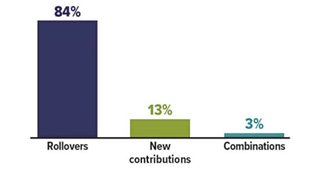How Well Do You Understand Retirement Plan Rules?

Qualified retirement plans, such as IRAs and 401(k)s, have many rules, and some of them can be quite complicated. Take the following quiz to see how well you understand some of the finer points.
1. You can make an unlimited number of retirement plan rollovers per year.
A. True
B. False
C. It depends
C. It depends. Rollovers can be made in two ways — through a direct rollover, also known as a trustee-to-trustee transfer, in which you authorize the funds to be transferred directly from one account or institution to another, or through an indirect rollover, in which you receive a check in your name (less a required tax withholding) and then reinvest the full amount (including the amount withheld) in a tax-deferred account within 60 days. If the full amount is not reinvested, the outstanding amounts will be considered a distribution and taxed accordingly, including any applicable penalty. Generally, individuals can make an unlimited number of rollovers in a 12-month period, either direct or indirect, involving employer-sponsored plans, as well as an unlimited number of direct rollovers between IRAs; however, only one indirect (60-day) rollover between two IRAs is permitted within a 12-month period.
2. If you roll money from a Roth 401(k) to a Roth IRA, you can take a tax-free distribution from the Roth IRA immediately as long as you have reached age 59½.
A. True
B. False
C. It depends
C. It depends. Beware of the five-year rule as it applies to Roth IRAs. If you establish your first Roth IRA with your Roth 401(k) rollover dollars, you will have to wait five years to make a qualified withdrawal from the Roth IRA, regardless of how long you've held the money in your Roth 401(k) account, even if you are over 59½. However, if you have already met the five-year holding requirement with any Roth IRA, you may take a tax-free, qualified withdrawal.
3. You can withdraw money penalty-free from both your 401(k) and IRA (Roth or traditional) to help pay for your children's college tuition or to pay for health insurance in the event of a layoff.
A. True
B. False
C. It depends
B. False. You can take penalty-free withdrawals from an IRA, but not from a 401(k) plan, to pay for a child's qualifying education expenses or to pay for health insurance premiums in the event of a job loss. Note that ordinary income taxes will still apply to the taxable portion of the distribution, unless it's from a Roth account that is otherwise qualified for tax-free withdrawals.
4. If you retire or otherwise leave your employer after age 55, you can take penalty-free distributions from your 401(k) plan. You can't do that if you roll 401(k) assets into an IRA.
A. True
B. False
C. It depends
True. If you leave your employer after you reach age 55, you may want to consider carefully whether to roll your money into an IRA. Although IRAs may offer some advantages over employer-sponsored plans — such as a potentially broader offering of investment vehicles — you generally cannot take penalty-free distributions from an IRA between age 55 and 59½, as you can from a 401(k) plan if you separate from service. If you might need to access funds before age 59½, you could leave at least some of your money in your employer plan, if allowed.
Shares of Traditional IRA Assets Opened with...

Source: Investment Company Institute, 2020 (data reflects IRAs opened in 2016)
When leaving an employer, you generally have several options for your 401(k) plan dollars. In addition to rolling money into an IRA and leaving the money in your current plan (if the plan balance is more than $5,000), you may be able to roll the money into a new employer's plan or take a cash distribution, which could result in a 10% tax penalty (in addition to ordinary income taxes) on the taxable portion, unless an exception applies.
Contact our Financial Advisors
Sign up for our monthly newsletter
To the extent that this material concerns tax matters, it is not intended or written to be used, and cannot be used, by a taxpayer for the purpose of avoiding penalties that may be imposed by law. Each taxpayer should seek independent advice from a tax professional based on his or her individual circumstances. These materials are provided for general information and educational purposes based upon publicly available information from sources believed to be reliable—we cannot assure the accuracy or completeness of these materials. The information in these materials may change at any time and without notice.
Non-deposit investment products and services are offered through CUSO Financial Services, LP ("CFS") a registered broker-dealer (Member FINRA/SIPC) and SEC Registered Investment Advisor. Products offered through CFS: are not NCUA/NCUSIF or otherwise federally insured, are not guarantees or obligations of the credit union, and may involve investment risk including possible loss of principal. Investment Representatives are registered through CFS. The Credit Union has contracted with CFS for investment services. Atria Wealth Solutions, Inc. ("Atria") is a modern wealth management solutions holding company. Atria is not a registered broker-dealer and/or Registered Investment Advisor and does not provide investment advice. Investment advice is only provided through Atria's subsidiaries. CUSO Financial Services, LP is a subsidiary of Atria.
Copyright 2006- Broadridge Investor Communication Solutions, Inc. All rights reserved.
Broadridge Investor Communication Solutions, Inc. does not provide investment, tax, or legal advice. The information presented here is not specific to any individual’s personal circumstances.